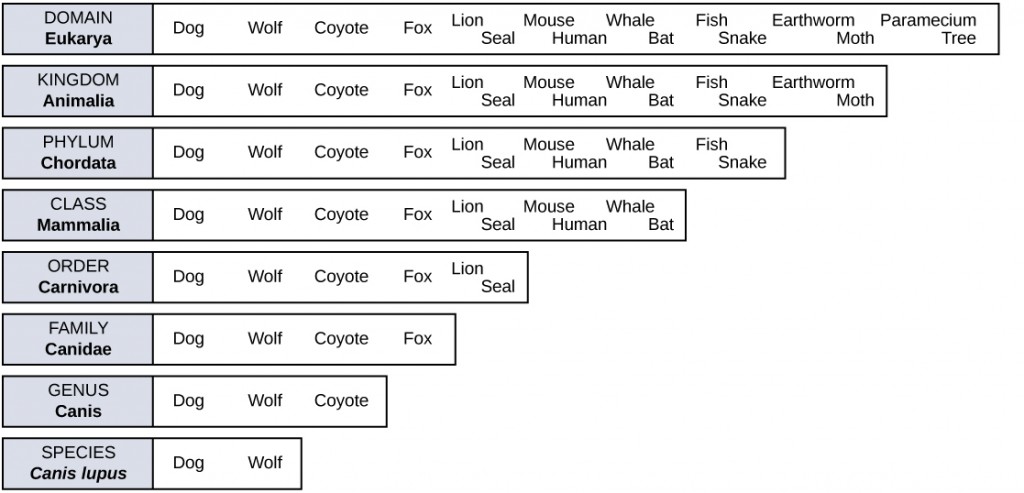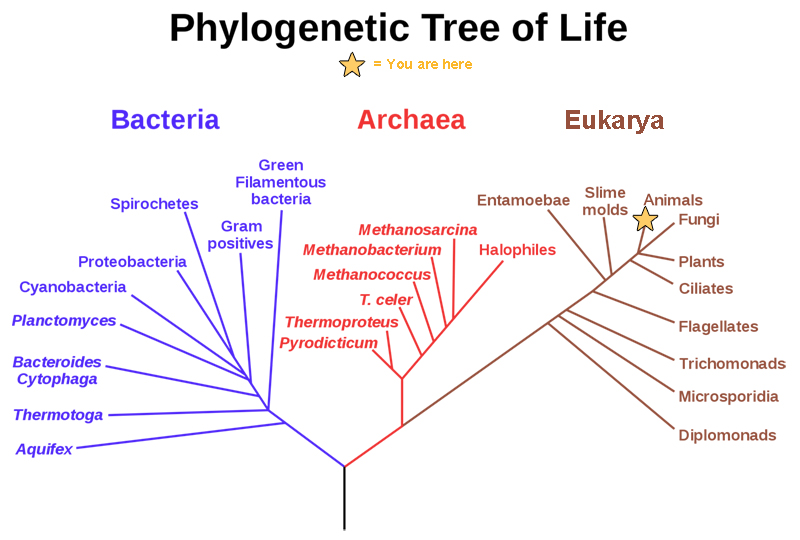2.3 The Diversity of Life and Evolution
Learning Objectives
By the end of this section, you will be able to:
- Understand the relationship between the diversity of life and evolution.
- Identify the levels of the hierarchical taxonomy system.
- Explain what a phylogenetic tree is and how it is used to show evolutionary relationships.
The science of biology is very broad in scope because there is a tremendous diversity of life on Earth. The source of this diversity is evolution, the process of gradual change during which new species arise from older species. Evolutionary biologists study the evolution of living things in everything from the microscopic world to ecosystems. In the 18th century, a scientist named Carl Linnaeus first proposed organizing the known species of organisms into a hierarchical taxonomy. In this system, species that are most similar to each other are put together within a grouping known as a genus. Furthermore, similar genera (the plural of genus) are put together within a family. This grouping continues until all organisms are collected together into groups at the highest level. The current taxonomic system now has eight levels in its hierarchy, from highest to lowest, they are: domain, kingdom, phylum, class, order, family, genus, species. Thus species are grouped within genera, genera are grouped within families, families are grouped within orders, and so on. A mnemonic, or memory trick, to remember this system is “Dear King Philip Came Over For Good Soup.”

The highest level, domain, is a relatively new addition to the system since the 1990s. Scientists now recognize three domains of life, the Eukarya, the Archaea, and the Bacteria. The domain Eukarya contains organisms that have cells with nuclei. It includes the kingdoms of fungi, plants, animals, and several kingdoms of protists. The Archaea, are single-celled organisms without nuclei and include many extremophiles that live in harsh environments like hot springs. The Bacteria are another quite different group of single-celled organisms without nuclei. Both the Archaea and the Bacteria are prokaryotes, an informal name for cells without nuclei. The recognition in the 1990s that certain “bacteria,” now known as the Archaea, were as different genetically and biochemically from other bacterial cells as they were from eukaryotes, motivated the recommendation to divide life into three domains. This dramatic change in our knowledge of the tree of life demonstrates that classifications are not permanent and will change when new information becomes available.
In addition to the hierarchical taxonomic system, Linnaeus was the first to name organisms using two unique names, now called the binomial naming system. Before Linnaeus, the use of common names to refer to organisms caused confusion because there were regional differences in these common names. Binomial names consist of the genus name (which is capitalized) and the species name (all lower-case). Both names are set in italics when they are printed. Every species is given a unique binomial which is recognized the world over, so that a scientist in any location can know which organism is being referred to. For example, the North American blue jay is known uniquely as Cyanocitta cristata. Our own species is Homo sapiens.

Phylogenetic Trees
The evolutionary relationships of various life forms on Earth can be summarized in a phylogenetic tree. A phylogenetic tree is a diagram showing the evolutionary relationships among biological species based on similarities and differences in genetic or physical traits or both. A phylogenetic tree is composed of branch points, or nodes, and branches. The internal nodes represent ancestors and are points in evolution when, based on scientific evidence, an ancestor is thought to have diverged to form two new species. The closer together two branches are on the tree, the closer two organisms are thought to be related to each other. The length of each branch can be considered as estimates of relative time. In the past, biologists grouped living organisms into five kingdoms: animals, plants, fungi, protists, and bacteria. The pioneering work of American microbiologist Carl Woese in the early 1970s has shown, however, that life on Earth has evolved along three lineages, now called domains—Bacteria, Archaea, and Eukarya. Woese proposed the domain as a new taxonomic level and Archaea as a new domain, to reflect the new phylogenetic tree. Many organisms belonging to the Archaea domain live under extreme conditions and are called extremophiles. To construct his tree, Woese used genetic relationships rather than similarities based on morphology (shape). Various genes were used in phylogenetic studies. Woese’s tree was constructed from comparative sequencing of the genes that are universally distributed, found in some slightly altered form in every organism, conserved (meaning that these genes have remained only slightly changed throughout evolution), and of an appropriate length.

Glossary
binomial naming system: a formal system in Latin for naming species of living things using two parts:
1. Genus: The first part of the name identifies the genus to which the species belongs
2. Species: The second part of the name identifies the species itself
This system is used internationally by scientists so that they can identify when they are referring to the same organism no matter what country or region the scientist comes from or what language the scientist speaks
common names: names for living organisms that differ based on region.
comparative sequencing: a biological research field that compares the genome sequences of different species to identify similarities and differences
eukarya: domain of taxonomy that contains organisms that have cells with nuclei.
evolutionary biologists: biologist who study the evolution of living things
hierarchical taxonomy: a system that organizes organisms into a series of biological classification levels based on . The current taxonomic system has the following eight levels: domain (the most broad), kingdom, phylum, class, order, family, genus, species (the most specific).
Example: taxonomy for human = Domain: Eukarya, Kingdom: Animalia, Phylum: Chordata, Class: Mamallia, Order: Primate, Family: Hominidae, Genus: Homo, Species: Sapiens
microscopic: so small as to be visible only with a microscope
mnemonic: a device such as a pattern of letters, ideas, or associations that assists in remembering something
phylogenetic tree: a diagram showing the evolutionary relationships among biological species based on similarities and differences in genetic or physical traits or both.
prokarya: domain of taxonomy that contains organisms that have cells without nuclei.
References
Mt Hood Community College Biology 101 Copyright © 2016 by Lisa Bartee and Christine Anderson is licensed under a Creative Commons Attribution 4.0 International License, except where otherwise noted.
Unless otherwise noted, images on this page are licensed under CC-BY 4.0 by OpenStax.
Text adapted from: OpenStax, Concepts of Biology. OpenStax CNX. May 18, 2016 http://cnx.org/contents/b3c1e1d2-839c-42b0-a314-e119a8aafbdd@9.10
Media Attributions
- Figure_01_02_04-183×3002-1

